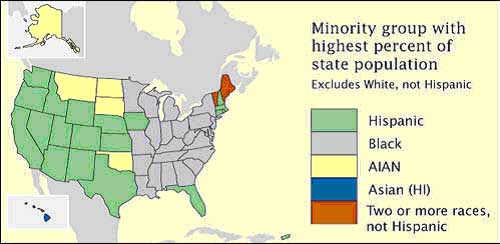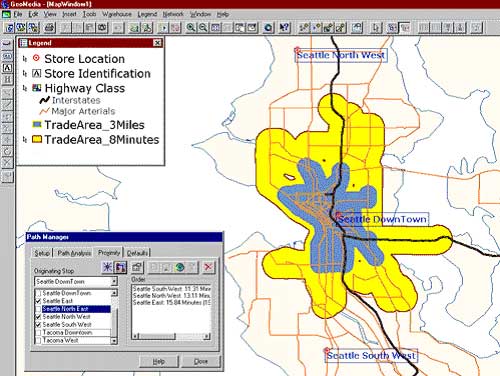Penn State defines academic integrity as "the pursuit of scholarly activity in an open, honest and responsible manner." Academic integrity includes "a commitment not to engage in or tolerate acts of falsification, misrepresentation, or deception." In particular, the University defines plagiarism as "the fabrication of information and citations; submitting other's work from professional journals, books, articles, and papers; submission of other student's papers, lab results or project reports and representing the work as one's own." Penalties for violations of academic integrity may include forfeited assignments, course failure, or disqualification from a degree or certificate program. The academic integrity policy of Penn State's College of Earth and Mineral Sciences (which includes the Department of Geography) is published at the Earth and Mineral Sciences website.
Citation and Reference Style
We expect that the text and graphics you submit as part of your assignments are original. We use the plagiarism detection service Turnitin.com to assure the originality of project assignments. You may build upon ideas, words, and illustrations produced by others, but you must acknowledge such contributions formally. Unacknowledged contributions are considered to be plagiarized. This guide explains when and how you should acknowledge contributions of others to your own work.
Different disciplines adopt different standards for citations and references. Moreover, almost every professional publication enforces its own variation on the standard styles. The most widely used styles include:
- APA - Used in psychology, education, and other social sciences;
- MLA - Used in literature, arts, and humanities;
- AMA - Used in medicine, health, and biological sciences;
- Turabian - Designed for college students to use with all subjects;
- Chicago - Used with all subjects in non-academic publications like books, magazines, and newspapers.
For your Project reports in this course we recommend that you use the APA style, documented at the Purdue Online Writing Lab. Recognizing that many variations of APA style are in use, we do not enforce the Purdue style strictly. However, we do expect two things:
- Whenever you include text, a graphic, or an idea that is not your own, acknowledge the contribution in such a way that enables readers to find the original source; and
- Consistently apply one style of citations and references throughout all your assignments.
A. Text ("In-line") Citations
We expect parenthetical citations that include author(s) name(s) and year of publication.
Quotations: Page numbers should also be included when direct quotations are cited. Complete references corresponding to each citation should appear in the reference list at the end of every assignment report.
| Text Citations Example #1: A Quotation | List the author(s), date of publication and page number in parentheses at the end of the sentence with the quotation. Does geographic information science merit recognition as a distinct field? Some claim that the distinction is justified, but only if "we...first establish that spatial, or rather, geographical, data are unique" (Goodchild, 1992, p. 32). |
|---|
Paraphrasing: Most often, you will cite ideas rather than quotations. Your ability to paraphrase and build upon the work of others constitutes more convincing evidence of your professional and intellectual development than your ability to assemble series of quotations. The Student Judicial Services office at the University of Texas has published the following excellent explanation of proper paraphrasing (note the extended quotation is set apart as a "block quote"):
- Like a direct quotation, a paraphrase is the use of another's ideas to enhance one's own work. For this reason, a paraphrase, just like a quotation, must be cited. In a paraphrase, however, the author rewrites in his or her own words the ideas taken from the source. Therefore, a paraphrase is not set within quotation marks. So, while the ideas may be borrowed, the borrower's writing must be entirely original; merely changing a few words or rearranging words or sentences is not paraphrasing. Even if properly cited, a paraphrase that is too similar to the writing of the original is plagiarized.
- Good writers often signal paraphrases through clauses such as "Werner Sollors, in Beyond Ethnicity, argues that..." Such constructions avoid excessive reliance on quotations, which can clog writing, and demonstrate that the writer has thoroughly digested the source author's argument. A full citation, of course, is still required. When done properly, a paraphrase is usually much more concise than the original and always has a different sentence structure and word choice. Yet no matter how different from the original, a paraphrase must always be cited, because its content is not original to the author of the paraphrase (Student Judicial Services Center, University of Texas, no date).
| Text Citations Example #2: A Paraphrased Idea | List author and the date in parentheses at the end of the relevant sentence.
Geographic information science ought to be considered a distinct field because georeferenced data embody unique characteristics (Goodchild, 1992). Another way this idea might have been cited is to mention the author directly followed by the date in parenthesis. Goodchild (1992) argues that geographic information science ought to be considered a distinct field because georeferenced data embody unique characteristics. |
|---|
B. Graphics Citations
In the same way that you may quote and acknowledge limited passages of published text, you may also include illustrations created by others in your assignments. However, works produced by others included in your assignments without acknowledgment are considered to be plagiarized. What constitutes proper acknowledgment for graphics? That depends on the affiliation of the author(s).
Public domain graphics: Any illustration produced by an employee of an agency of the U.S. government is said to be in the "public domain"--meaning that it is not subject to copyright, and can be reused without permission. Students should acknowledge such works, however, with the names or affiliations of the authors and the publication date, as shown in Example 1 below. Full citations should follow in the list of references at the end of your report.
| Graphics Citations Example #1 - Public Domain Source |  Choropleth map showing nominal-level data (Brewer and Suchan, 2001). |
|---|
Copyrighted graphics: Any illustration not produced by an employee of an agency of the U.S. government is protected by copyright law. In general, copyrighted illustrations should only be used with authors' written permission. A provision of copyright law called "fair use" permits reuse of copyrighted illustrations for strictly educational purposes, however. (You can learn more about fair use at the Stanford University Libraries). In the context of your studies at Penn State, you may reuse copyrighted illustrations without permission provided that you include in your caption a parenthetical citation with the names or affiliations of the authors and the publication date. Additionally, you must acknowledge the authors' copyright, and state that you have used the illustration for educational purposes only. Full citations should follow in the reference list at the end of your report.
| Graphics Citations Example #2 - Copyrighted Source |  Trade areas defined by 3 miles travel distance (blue) and 8 minutes travel time (yellow) (Francica, 1999). ©1999 Geodezix. All rights reserved. Reproduced here for educational purposes only. |
|---|
C. References
At the end of your report, you must list the full bibliographic citations of the works you have used. The list should be alphabetized and references should include the following:
- Author(s) name(s)
- Publication date
- Publication title
- Editors (if publication appears in an edited collection)
- Edition title and number (if applicable)
- URL (if applicable)
- Date retrieved (for web publications)
- City, State and Name of publisher (if applicable)
- Page number (for quotations from printed sources)
| Basic Book | Author, A. A. (Year of publication). Title of work: Subtitle. Location: Publisher. Chrisman, N. (1997). Exploring geographic information systems. New York: John Wiley & Sons, Inc. |
|---|---|
| Chapter of an Edited Book | Author, A. A., & Author, B. B. (Year of publication). Title of chapter. In A. Editor & B. Editor (Eds.), Title of book (pages of chapter). Location: Publisher. Cowen, D. J., & Jensen, J. R. (1998). Extraction and Modeling of Urban Attributes Using Remote Sensing Technology. In D. Liverman, E. F. Moran, R. R. Rindfuss & P. C. Stern (Eds.), People and Pixels: Linking Remote Sensing and Social Science (pp. 164 – 188). Washington, D. C.: National Academy Press, National Research Council.</author,> |
| Edition other than first | Author, A. A. (Year of publication). Title of work: Subtitle. (# ed.). Location: Publisher. Lillesand, T., & Kiefer, R. (1994). Remote sensing and image interpretation (3rd ed.). New York, NY: John Wiley and Sons. |
| Article in a Periodical | Author, A. A., Author, B. B., & Author, C. C. (Year). Title of article. Title of Periodical, volume number(issue number), pages. Goodchild, M. (1992). Geographical information science. International Journal of Geographic Information Systems 6:1, 31-45. |
| Electronic Source |
Author, A. A., & Author, B. B. (Date of publication). Title of document. Retrieved month date, year, from http://www.someaddress.com/full/url/ TopoZone.com. (n. d.). Welcome to TopoZone. Retrieved February 4, 2007, from http://www.topozone.com (In this particular case "n.d." stands for "no date of publication available"--which is sometimes the case for online sources.) |
| Article from an Online Periodical | Author, A. A., & Author, B. B. (Date of publication). Title of article. Title of journal, volume number(issue number if available). Retrieved month day, year, from http://www.someaddress.com/full/url/ Bernstein, M. (2002). 10 tips on writing the living Web. A List Apart: For People Who Make Web sites, 149. Retrieved May 2, 2006 from http://www.alistapart.com/articles/writeliving |
| Citing this Course Text |
DiBiase, D. and others (2015). Nature of Geographic Information. The Pennsylvania State University. Retrieved [month day, year] from http://natureofgeoinfo.org. (If you cite the course text more than once, using multiple pages from multiple chapters, include the chapter and online page number after DiBiase in each of your inline citations and eliminate it from your source list entry.) e.g., (DiBiase, 2015, Ch. 2, p. 17) for example, or (DiBiase, 2015, Ch. 3, p. 2) for another |
| Topographic Map | Author. “Sheet title” (date). [format]. Edition. Scale. Series, sheet number. Place of publication, Date. United States Geologic Survey. "Bellefonte, PA Quadrangle" (1971). [map]. 1:24 000. 7.5 minute series. Washington, D.C.:USGS. |
D. Regarding online sources
Websites have become a popular source for research and are especially useful to students in an online learning environment, where distance to the home campus or access to materials can be prohibitive. However, unlike printed material, Web pages change frequently, and a source that is available may at some future point disappear. One solution we can suggest, which is purely optional, is WebCite®.
What Is WebCite®?
Web pages cited in scholarly works are susceptible to the problem of "link rot"--the process by which the links on Web pages become unavailable for various reasons. To prevent readers from accessing Web citations only to find a “404: File Not Found” response, authors and publishers may use a free, non-profit archiving tool called WebCite®. WebCite® permanently archives web pages and websites to ensure that when they are accessed they appear exactly as the citing author originally saw and used them, even after the original link has expired. Visit: www.webcitation.org to learn how WebCite® works.